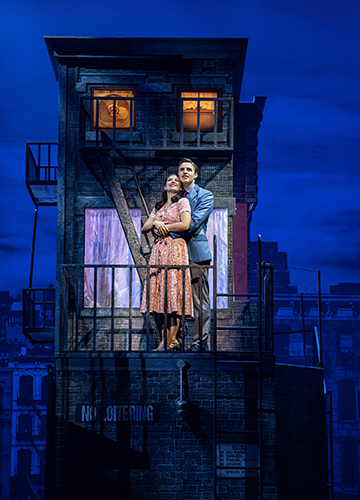West Side Story has come to India for the first time. The classic Broadway musical―which captures a Romeo-Juliet love story set in 1950s New York, amid the fierce rivalry between the white American Jets and the newly-arrived Puerto Rican Sharks―is theatre at its most captivating. In the derelict streets and backyards of the Upper West Side, the two groups fight for a stake in the American dream, even as there blossoms the love between Tony of the Jets and Maria of the Sharks.
Renowned Broadway director Lonny Price retains the original concept and choreography by Jerome Robbins, lyrics by Stephen Sondheim, and music by Leonard Bernstein―even as he gives it some context. With a new international creative team, Price kickstarted a multi-year world tour in December 2022, of which India is a stop. The performances are pulsating and the set is evocative. The brown stone buildings perfectly resemble a suburban neighbourhood. All the actors are stylishly dressed in costumes peculiar to 1950s America. A 34-member ensemble got finalised after auditioning over 3,000 aspirants. The show opens with the dominating presence of the Jets, and as they dance to Bernstein’s masterful score, you cannot help but get caught up in their entrancing performance.
Even as one struggles in the beginning to juxtapose the Romeo-Juliet love story into the gang war dynamics of yesteryear America, it does not take long to acclimatise. The musical then gives a wholesome experience, especially set in the Grand Theatre of the Nita Mukesh Ambani Cultural Centre (NMACC) in Mumbai, with top-notch acoustics. It is on till August 27. Even though Price could not make it here as he is working on another musical on Peter Pan (which he hopes to bring to India soon), he spoke with THE WEEK from the US about how he put it all together and what West Side Story means to him.
Q/ West Side Story has been regularly revived on Broadway as well as in films, including one by Steven Spielberg. What do you think about the musical’s evolution so far?
A/ When the show premiered on Broadway in 1957, it reflected the very particular gang war of the Puerto Ricans and the white Americans. Its evolution is interesting because it is really about xenophobia to some degree―vilifying others for not getting what you want or for taking away jobs, which encourages a lot of anger and violence. And very sadly, that is still with us, not just in our city, but all over the world. There is a tremendous epidemic of xenophobia. And then there’s the [Romeo and Juliet] love story, which is timeless. So, its appeal is universal. As for how it has evolved, I love the original 1961 film, which was my first exposure to the material. I fell in love with the power of Mr Bernstein’s score. It is one of the masterpieces of American musical theatre. And what is interesting about the music is that it does not feel like it was written in the 1950s. It feels as fresh and vibrant as if it were written today. And I don’t think he would change [anything] if he wrote it today.
Q/ Everything in West Side Story gives an impression of wildness, ecstasy and anguish. Tell us more about your own takeaway after you first watched it, and then years later when you directed it.
A/ I love those three words―wildness, anguish and ecstasy. That is what my sad story is about. I first probably saw it in the mid-1960s, when I was very small. And what I took away from it was mostly the music and the dancing, and Jerome Robbins’s utterly iconic choreography, which I think has never been surpassed on stage. And [right now], we are doing the original. So I think the power of the score and the story struck me as a young man. We have the album of the Broadway show in my home, as my parents love theatre music. So that was one of the albums that [I listened to] while growing up. In a way, I feel like I was indoctrinated with this music. As the director, the only thing that I tried to do in this production was to give it a little context. In the backdrop [of the play], for example, there are advertisements of white post-war America, where white people are enjoying the country’s affluence after the war, with big cars, refrigerators, and work suits, and a life that teased others.
It was a myth that anyone could have the American dream, a kind of lie. I think the rest of the world knows it is a lie. But for some reason, we like to believe this myth. And so we have put these advertisements of happy white people all over the set. And why, because of the colour of their skin and for socio-economic reasons, some will never attain that American dream. It is not available to them. And yet, it is always playing before them, as if they are being teased about something that they will never have, but they are forced to look at all the time. There is the vilification of the other as the two groups [the Puerto Ricans and the Americans] blame each other for not being able to achieve that American dream, so that’s the context. But other than that, we have not changed a line of the dialogue or a note of the music. It is the same as it was in 1957. It was not broken, so it did not need to be fixed. It has been doing very well for over 60 years. So we have just given it a little context. But as a director, I wanted to remind people of what both these factions are facing in terms of the American dream.
Q/ How does the current rendition of the play negotiate its relationship with the evolving city of New York?
A/ I don’t think New York has changed that much since 1957, not the energy or the vibrancy of it. There are different gangs now, but I don’t think things are that different. Sadly, this is why the play remains relevant even today. Also, another aspect that makes West Side Story so current and relatable is that it reflects the romanticism of the city amid its grit and grime.
Q/ The play has come to India for the first time. What has been your takeaway?
A/ First of all, I am thrilled that we are here. I mean, what an honour to play here for the first time. I wish I was there with you. But I am busy working on another show based on Peter Pan in New York. But I just think it is amazing that it has taken this long for West Side Story to come to India, and I hope it inspires and entertains people there in the same way that it has in our world.
Q/ Why according to you does West Side Story continue to have such a wide cultural footprint?
A/ The musical is very successful in Japan, as well as in Europe and in the US. So, it is really extraordinary when you think about it, that it has that kind of power for every culture. And to think that what Arthur Laurents, Leonard Bernstein and Jerome Robbins did all those years ago stays relevant and speaks to people all over the world still. I don’t know of another show that has had this kind of broad appeal.
Q/ Which segment of West Side Story is closest to your heart?
A/ I think it is the ‘Dance at the Gym,’ when Tony and Maria meet, and then they do a little ‘cha cha’ with each other. The simplicity of the dance moves me to tears every time I see it. There is no contribution of mine, yet it moves me.
Q/ As a director, what was your biggest challenge?
A/ It is difficult to get performers who can seamlessly sing, dance and act. In the olden days, the dancing and the singing were separate. This is the first time that all three disciplines have to be embodied in one performer. If you cannot dance, you cannot be in West Side Story. So then, having the dancers be able to sing well enough for Mr Bernstein, and then be good actors, too―that was hard. We auditioned a lot of people and that alone was the most challenging thing. The cast has to be perfect at all times.




